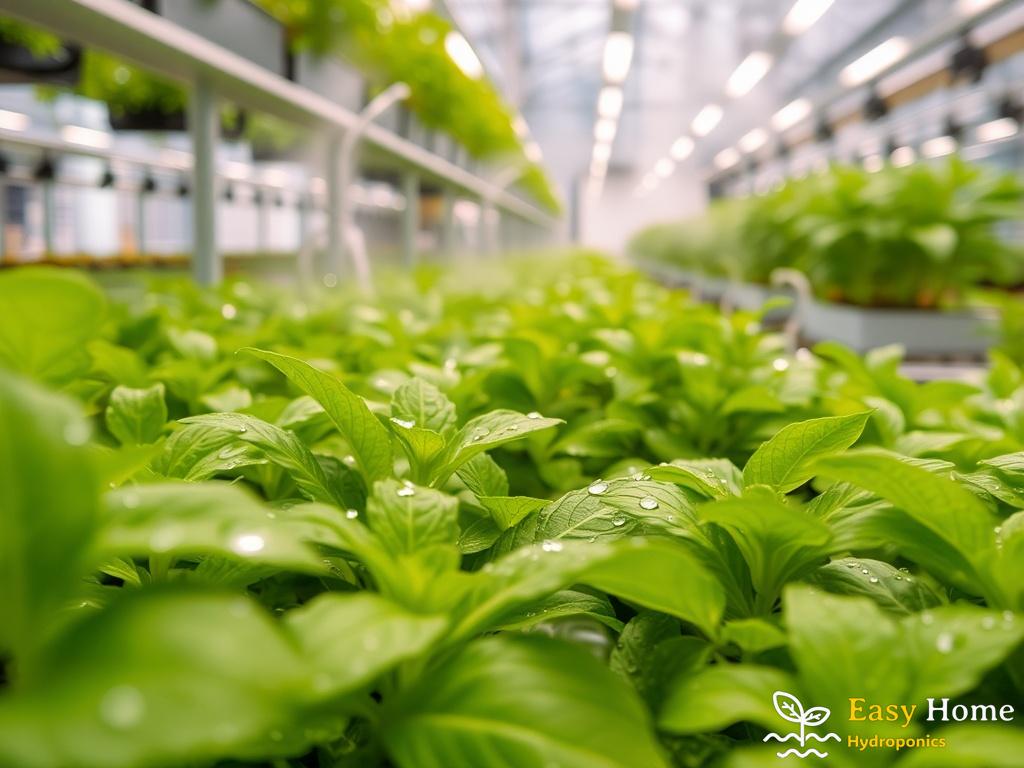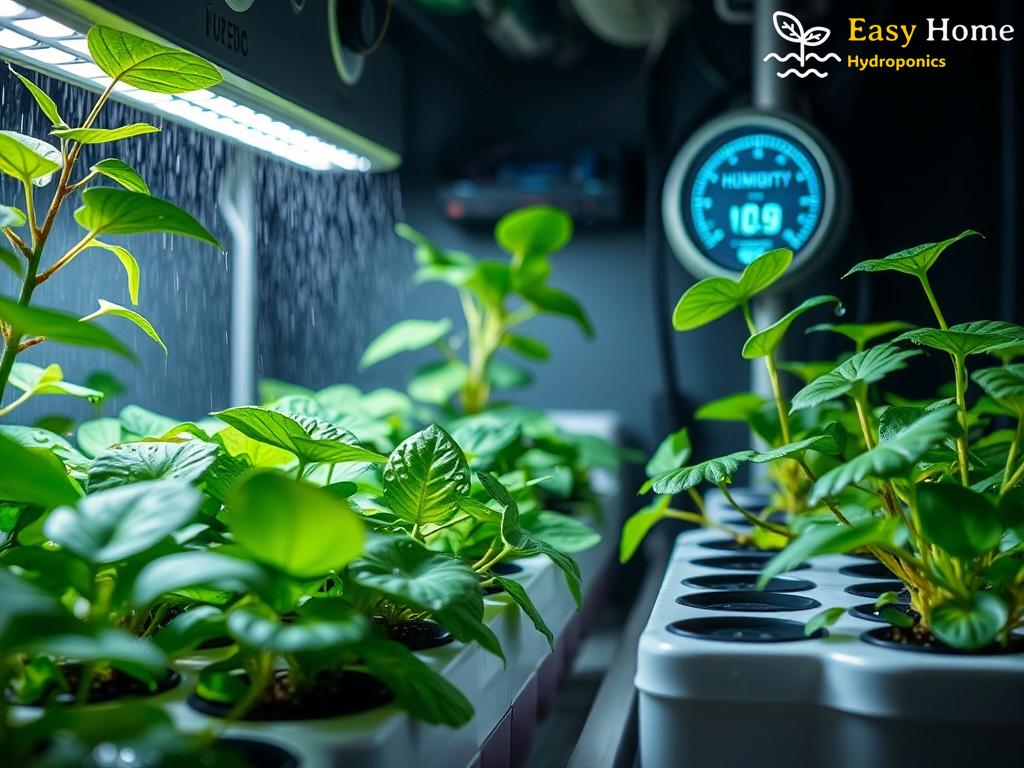Humidity: The Secret Ingredient for Hydroponic Success

Why Humidity Matters in Hydroponics
In the world of hydroponics, where plants are grown without soil, humidity plays a pivotal role in determining the success of your crops. Many enthusiasts often overlook this critical factor, focusing solely on nutrient solutions and light. However, understanding and managing humidity levels can significantly enhance plant growth, yield, and overall health.
Humidity, defined as the amount of water vapor present in the air, directly influences transpiration—the process by which plants absorb water and nutrients through their roots and release moisture through their leaves. When humidity levels are optimal, plants thrive; when they are too high or too low, growth can be stunted, leading to a cascade of issues.
The Humidity Goldilocks Zone: Just Right for Growth
Finding the perfect humidity level for hydroponic plants can feel like a balancing act. Different plants have varying humidity preferences, but most thrive in a range of 40% to 70% relative humidity. Let’s delve into the effects of both high and low humidity on plant growth.
| Humidity Level | Effects on Plants |
|---|---|
| Low Humidity (<40%) | Increased transpiration leading to water stress, nutrient deficiencies, and wilting. |
| Optimal Humidity (40%-70%) | Encourages healthy growth, vibrant foliage, and maximum nutrient absorption. |
| High Humidity (>70%) | Risk of mold, fungal diseases, and poor air circulation, which can suffocate plants. |
Mastering Humidity Control Techniques
To harness the power of humidity for hydroponic success, growers can employ several techniques. Below is a list of effective strategies to monitor and control humidity levels in your hydroponic garden:
- Use Humidity Sensors: Invest in reliable hygrometers to keep track of moisture levels in real-time.
- Ventilation Systems: Implement exhaust fans and intake vents to promote air circulation and help regulate humidity.
- Dehumidifiers: For areas with high ambient humidity, dehumidifiers can be a lifesaver in maintaining optimal conditions.
- Humidity Domes: For seedlings and young plants, humidity domes can create a microclimate that fosters growth.
- Watering Techniques: Adjust your watering schedule to avoid excess moisture, which can lead to high humidity levels.
By understanding and controlling humidity, hydroponic growers can create an environment that promotes robust plant growth, ensuring a bountiful harvest.
Balancing Act: Humidity Levels and Plant Health

In the intricate dance of hydroponic gardening, maintaining the right humidity is akin to finding the perfect melody. Too much or too little can disrupt the harmony, leading to a host of health issues for your plants. The delicate balance between humidity levels and plant health is not just a scientific principle; it is a crucial factor that every hydroponic gardener must master to achieve thriving crops.
The Impact of Humidity on Plant Physiology
Humidity levels directly affect the transpiration rate, which is vital for nutrient uptake and overall plant health. When humidity levels are within the sweet spot of 40% to 70%, plants can efficiently absorb water and nutrients through their roots while releasing moisture from their leaves. However, when humidity dips below this range, plants can struggle to retain moisture, leading to wilting and stunted growth. Conversely, excessive humidity can create a breeding ground for diseases, such as mold and root rot, which can devastate an entire crop.
Perfecting the Humidity Balance for Optimal Growth
Achieving a perfect humidity balance is not a one-size-fits-all scenario. Different plant species exhibit unique preferences for humidity, and understanding these nuances is essential for success. For instance, tropical plants often thrive in higher humidity levels, while succulents and cacti prefer drier conditions. To maintain this balance, hydroponic gardeners can utilize a combination of environmental controls such as dehumidifiers, humidifiers, and advanced ventilation systems. Additionally, monitoring humidity with reliable sensors can help you react promptly to changing conditions, ensuring your plants remain in their ideal environment.
Moreover, the timing of watering plays a crucial role in maintaining humidity levels. Overwatering can lead to excess moisture in the air, while under-watering can cause humidity to plummet. Striking the right balance requires keen observation and adjustments based on the specific needs of each plant type.
The Science of Vapor: How Humidity Affects Nutrient Uptake
Understanding the intricate relationship between humidity and nutrient uptake is essential for hydroponic success. As plants engage in the process of transpiration, they not only manage their water levels but also facilitate nutrient absorption from their surroundings. The vapor in the air, often overlooked, plays a crucial role in this delicate balance.
Humidity and the Transpiration Process
Transpiration is the natural mechanism through which plants lose water vapor from their leaves, creating a negative pressure that aids in drawing up essential nutrients from the roots. This process is heavily influenced by humidity levels. When humidity is within the optimal range of 40% to 70%, plants can efficiently release moisture, ensuring a steady supply of nutrients. However, when humidity levels drop, plants tend to close their stomata—the tiny pores on leaves—to conserve water, thereby reducing their ability to take in nutrients.
The Nutrient Uptake Dynamics
The efficiency of nutrient uptake is not just about the roots absorbing nutrients; it is also about the plant’s ability to transpire effectively. In conditions of high humidity, although moisture is abundant, transpiration slows down, which can lead to nutrient lockout. Conversely, low humidity can spur excessive transpiration, causing plants to struggle with nutrient absorption. Thus, the interplay between humidity and nutrient availability creates a dynamic that every hydroponic gardener should master.
To better illustrate how humidity influences nutrient uptake, consider the following key points:
- Optimal Humidity Levels: Maintaining humidity around 60% allows for efficient nutrient transport and uptake.
- Impact of Extreme Humidity: High humidity can lead to nutrient deficiencies as plants struggle to transpire; low humidity can cause stress, leading to poor growth.
- Role of Temperature: Warmer temperatures combined with the right humidity can enhance nutrient absorption, while cold, damp conditions can inhibit it.
By fine-tuning humidity levels, hydroponic gardeners can optimize the nutrient uptake process, resulting in healthier plants and more fruitful yields. With a deeper understanding of the science of vapor, growers can unlock the full potential of their hydroponic systems.
Humidity Control: Tools and Techniques for Optimal Growth
For hydroponic gardeners, mastering humidity is not just a beneficial skill; it’s an art form that can dramatically influence the vitality and productivity of their crops. With the right tools and techniques, growers can create an ideal environment that maximizes growth potential. Understanding the specific needs of your plants in relation to humidity is essential, as it allows for the implementation of the most effective strategies to achieve success.
Hygrometers: Your Humidity Detectives
One of the first steps toward effective humidity control is the use of hygrometers. These devices measure the moisture content in the air, providing invaluable data that helps gardeners maintain optimal conditions. By regularly monitoring humidity levels, you can make timely adjustments to your environment. For instance, if the humidity creeps above the desirable range, it might be time to consider enhancing ventilation or using a dehumidifier. Conversely, if levels drop too low, a humidifier can be employed to restore balance.
Ventilation Systems: The Breath of Fresh Air
Another critical component in humidity management is a well-designed ventilation system. Good airflow not only helps to regulate humidity but also promotes overall plant health by reducing the risk of mold and mildew. Implementing exhaust fans and intake vents can significantly enhance air circulation, allowing for a consistent exchange of moisture-laden air. This setup ensures that humidity levels remain in check, creating a stable environment for plant growth.
| Humidity Level | Recommended Action |
|---|---|
| Above 70% | Activate dehumidifier or enhance ventilation |
| Between 40% – 70% | Maintain current conditions |
| Below 40% | Introduce humidifier or misting system |
In addition to these tools, humidity domes are also beneficial for young plants and seedlings. These protective covers create a microenvironment that retains moisture, fostering an ideal growth scenario until the plants can thrive independently. By incorporating these techniques into your hydroponic setup, you take significant strides toward achieving optimal plant health.
Mistakes to Avoid: Common Humidity Missteps in Hydroponics
Overlooking Humidity Monitoring
One of the most significant blunders hydroponic growers make is neglecting to monitor humidity levels accurately. Many enthusiasts assume their indoor environment is stable, yet fluctuations can occur due to external factors such as weather changes or lighting schedules. Without regular assessment through reliable hygrometers, you risk entering a cycle of trial and error that can jeopardize plant health.
Common Consequences: Inconsistent humidity can lead to wilting, stunted growth, or even disease outbreaks. To avoid this, make humidity monitoring a daily habit, adjusting conditions as required to stay within the optimal range.
Failing to Adjust for Plant Variety
Each plant species has its own unique humidity needs, and applying a one-size-fits-all approach can be detrimental. For instance, tropical plants thrive in higher humidity levels, while succulents prefer drier air. Ignoring these variances can result in poor growth or, worse, plant death.
To navigate this, growers should familiarize themselves with the specific humidity preferences of the plants they are cultivating. Using the following list can help prioritize the needs of different species:
- Tropical Plants: 60%-80% humidity
- Vegetables: 40%-70% humidity
- Succulents and Cacti: Below 40% humidity
- Herbs: 50%-70% humidity
Ignoring Environmental Interactions
Humidity does not exist in isolation; it interacts with temperature, light, and airflow. Unfortunately, many growers overlook these relationships, leading to poor plant performance. For instance, high humidity paired with high temperatures can create a breeding ground for diseases like powdery mildew.
Holistic Approach: To optimize conditions, consider creating a comprehensive environmental strategy that includes not just humidity control, but also temperature regulation and adequate ventilation. This multifaceted approach creates a balanced ecosystem where plants can flourish.




